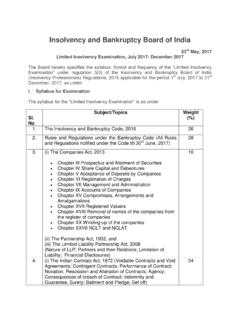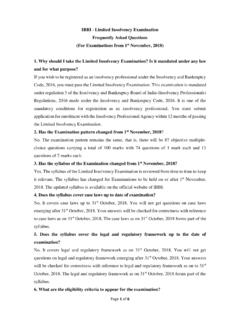Transcription of Understanding the IBC - Insolvency and Bankruptcy Board of ...
1 Understanding the IBCKEY JURISPRUDENCE AND PRACTICAL CONSIDERATIONSA HANDBOOK Simone D. McCourtie / World Bank Ray Witlin / World BankCover photos: Understanding the IBCKEY JURISPRUDENCE AND PRACTICAL CONSIDERATIONSA HANDBOOKKEY JURISPRUDENCE AND PRACTICAL CONSIDERATIONS3 The Insolvency space is extremely fertile, especially in a market economy. It acquires richness, depth and maturity with every transaction. The Insolvency regime in India is no exception. The Insolvency and Bankruptcy Code, 2016 (Code) has witnessed five legislative interventions since its enactment to strengthen the processes and further its objectives, in sync with the emerging market realities. There have also been dozens of amendments to the regulatory framework to smoothen the implementation of processes under the Code. The Adjudicating Authority, the Appellate Authority, High Courts, and the Supreme Court have all delivered numerous landmark orders and judgments explaining several conceptual issues, settling contentious issues and resolving grey areas.
2 Insolvency as a discipline of knowledge is now well established in India. A key pillar of the Insolvency ecosystem is the regulator, namely, the Insolvency and Bankruptcy Board of India (IBBI). It is responsible for professionalising Insolvency services through regulation and development of service providers, namely, Insolvency professionals, Insolvency professional agencies, Insolvency professional entities, information utilities, registered valuers, and registered valuers organisations. It has been the endeavour of the IBBI to ensure that the service providers are fit-and-proper persons and technically competent, and also have motivation and drive to uphold the highest standards of ethics and professionalism. In pursuance of this responsibility, the IBBI has been carrying out and promoting a variety of activities to build the capacity of service providers, and monitoring their conduct and performance closely.
3 The IBBI entered into a Cooperation Agreement with International Finance Corporation (IFC), a member of the World Bank Group, in 2019, which aims, inter alia, to further build capacity of Insolvency professionals. In pursuance of the said Agreement, IFC has prepared this Handbook detailing the four pillars of Insolvency ecosystem, and the provisions of law, practices and case laws in respect of corporate Insolvency resolution and liquidation processes. This Handbook captures the evolving discipline of Insolvency with all its nuances and is intended to serve as a single point of reference for Insolvency professionals, and all others in the ecosystem, who wish to study more and delve into this emerging area of law and practice. I may, however, add that this Handbook is designed for the sole purpose of education. I compliment IFC, and the authors who supported IFC, in preparation of this Handbook.
4 I sincerely believe that Insolvency professionals, prospective Insolvency professionals and other students of Insolvency and Bankruptcy would find this Handbook useful. Dr. M. S. SahooChairpersonInsolvency and Bankruptcy Board of IndiaForeword Foreword by IBBIUNDERSTANDING THE IBC4At the time of writing, the liquidity and solvency challenges triggered by the COVID-19 pandemic are expected to give rise to a wave of Bankruptcy filings across the globe. The lockdown and social distancing measures that are urgently needed to contain the pandemic, have disrupted business activity and their ability to pay creditors. Optimal Insolvency regimes are accordingly critical to facilitate the rescue of viable businesses and the efficient liquidation and market exit of non-viable businesses. On the other hand, weak Insolvency regimes, can push viable enterprises into non-viability through lengthy and overly complex restructuring procedures or lead to the proliferation of zombie firms that leach productive resources from the market.
5 The World Bank Group is a Financial Stability Board designated standard setter in the field of Insolvency and creditor rights alongside the United Nations Commission of International Trade Law. In this context, the World Bank has developed the principles for effective Insolvency and creditor/debtor regimes (ICR Principles) to assist countries with evaluating and strengthening their Insolvency regimes in line with best practices. One of the core components of the ICR Principles is promoting effective institutions, including courts, Insolvency regulators and Insolvency representatives. Strong institutions and professional actors promote transparency and predictability, which are key to a robust lending system and foster confidence. Investors need to assess their recovery risks including how security interests, enforcement rights and collective proceedings will be upheld through local this backdrop, the IFC Advisory Program has been providing technical support to the Insolvency & Bankruptcy Board of India (IBBI), one of the key cornerstones of the Indian Insolvency regime.
6 Since its enactment in 2016 , the Insolvency & Bankruptcy Code (IBC) has greatly strengthened the ability of stakeholders to maximize recovery through India s Insolvency regime. IBBI has played a leadership role, amongst its other responsibilities, in disseminating best practices and knowledge building tools to improve Understanding of the IBC and how it operates in Handbook provides one such tool to assist Insolvency professionals and all other stakeholders in the Insolvency ecosystem who wish to strengthen their Understanding of the IBC and related practice. It aims at providing education on the IBC, as well as practical skills and Understanding of implementation. Foreword Foreword by IFCKEY JURISPRUDENCE AND PRACTICAL CONSIDERATIONS5We would like to express our sincere thanks to all the personnel in the IBBI who have partnered with us in this important initiative and have guided us in its development, particularly Dr.
7 M. S Sahoo, Chairperson and Mr. Saji Kumar, Executive Director of the IBBI. We would also kindly thank Ms. Surbhi Kapur, Research Associate of the IBBI, for her support in preparing the Handbook. We would also like to thank the many Insolvency professionals, academics and other technical experts involved in this endeavour, who have provided their time and expertise so generously, in particular Ms. Pooja Mahajan (Managing Partner, Chandiok & Mahajan) and Mr. Neil Taylor (Managing Director, NTI) who worked tirelessly on the technical content of the Handbook. We would also like to recognize the organization and thought leadership of the World Bank Group team, including Rolf Behrndt (Practice Manager), Mahesh Uttamchandani (Practice Manager), Sagar Shankar (South Asia Regional Team) and Antonia Menezes (Global Insolvency & Debt Resolution Team) and the support of the India Country Management Unit and especially, Roshika Singh, Senior Country Officer.
8 Finally, we would like to acknowledge the funding support received by IFC, from the Government of Japan, for the development of this hope all readers find this Handbook useful and that it contributes towards strengthening the implementation of the IBC. Jun ZhangCountry Head IndiaInternational Finance CorporationUNDERSTANDING THE IBC6 ContentsForeword by IBBI 3 Foreword by IFC 4 Acronyms 9 Introduction 11 Module 1: The IBC Ecosystem 171.
9 Introduction 182. IBBI the Regulator 193. Information Utilities 234. Adjudicating Authority 285. Insolvency Professionals 326. Overriding Effect of the Code 56 Module 2: Initiating The CIRP 571.
10 Introduction 582. Flowchart of the CIRP Process 583. Commencement of the CIRP 594. Financial Creditors 605. Operational Creditors 666. Corporate Applicant 717. Fraudulent or Malicious Initiation of Proceedings 738.










